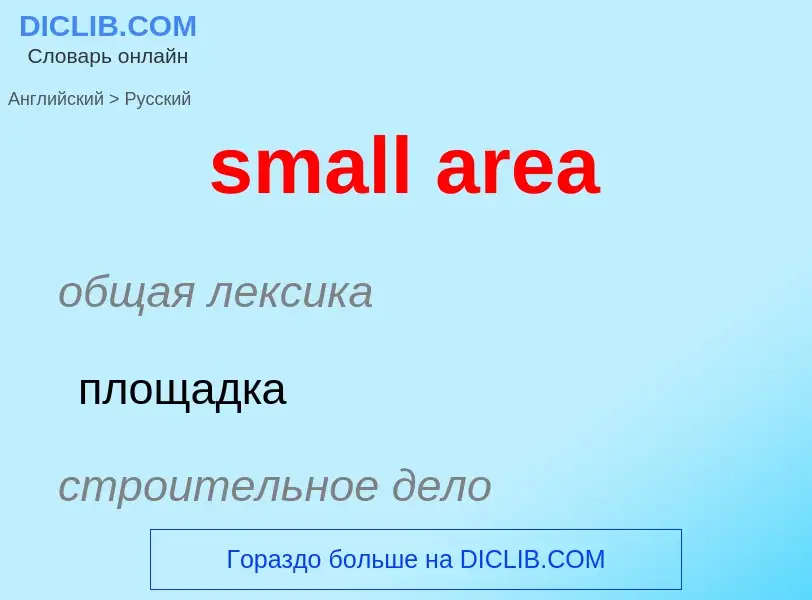Перевод и анализ слов искусственным интеллектом ChatGPT
На этой странице Вы можете получить подробный анализ слова или словосочетания, произведенный с помощью лучшей на сегодняшний день технологии искусственного интеллекта:
- как употребляется слово
- частота употребления
- используется оно чаще в устной или письменной речи
- варианты перевода слова
- примеры употребления (несколько фраз с переводом)
- этимология
small area - перевод на русский
общая лексика
площадка
строительное дело
элементарная площадка
общая лексика
тонкая кишка
[smɔ:lin'testin]
общая лексика
тонкая кишка
- closed area
- controlled area
- controlled access area
- fenced area
- fingerprint pattern area
- high risk area
- inaccessible area
- key area
- limited area
- logically protected area
- monitored area
- physically protected area
- protected area
- restricted area
- secret area
- secure area
- secure storage area
- security-sensitive area
- survey area
- target area
- user area
['e(ə)riə]
общая лексика
область
район
зона
ареал
область обитания
площадь
пространство
участок
область, участок
область памяти, часть экрана
сфера деятельности
область специализации
медицина
место
плоскость
строительное дело
площадь (помещения, поверхности, фигуры и т. п.)
площадка
внутренний двор
пространство, зона
приямок (напр. у окна подвального этажа)
нефтегазовая промышленность
поверхность
зона, район, область, территория, участок
существительное
общая лексика
площадь
пространство
участок
район
область
зона
сфера (деятельности)
область (исследования и т. п.)
размах
охват
сфера
проход
ведущий к входу в подвал
приямок перед окнами подвального этажа
площадь, пространство
край
размах, сфера
дворик ниже уровня улицы, через который проходят в полуподвал
анатомия
поле (коры головного мозга)
синоним
общая лексика
единица площади
Википедия
Small area estimation is any of several statistical techniques involving the estimation of parameters for small sub-populations, generally used when the sub-population of interest is included in a larger survey.
The term "small area" in this context generally refers to a small geographical area such as a county. It may also refer to a "small domain", i.e. a particular demographic within an area. If a survey has been carried out for the population as a whole (for example, a nation or statewide survey), the sample size within any particular small area may be too small to generate accurate estimates from the data. To deal with this problem, it may be possible to use additional data (such as census records) that exists for these small areas in order to obtain estimates.
One of the more common small area models in use today is the 'nested area unit level regression model', first used in 1988 to model corn and soybean crop areas in Iowa. The initial survey data, in which farmers reported the area they had growing either corn or soybeans, was compared to estimates obtained from satellite mapping of the farms. The final model resulting from this for unit/farm 'j' in county 'i' is , where 'y' denotes the reported crop area, is the regression coefficient, 'x' is the farm-level estimate for either corn or soybean usage from the satellite data and represents the county-level effect of any area characteristics unaccounted for.
The Fay-Herriot model, a random effects model, has been used to make estimates for small domains when the sample from each domain is too small for fixed effects.



![[[Micrograph]] of the small intestine [[mucosa]] showing the [[intestinal villi]] and [[crypts of Lieberkühn]]. [[Micrograph]] of the small intestine [[mucosa]] showing the [[intestinal villi]] and [[crypts of Lieberkühn]].](https://commons.wikimedia.org/wiki/Special:FilePath/Small intestine low mag.jpg?width=200)


![Fig 400]] Fig 400]]](https://commons.wikimedia.org/wiki/Special:FilePath/Sobo 1906 401.png?width=200)
![Small intestine [[in situ]], greater omentum folded upwards. Small intestine [[in situ]], greater omentum folded upwards.](https://commons.wikimedia.org/wiki/Special:FilePath/Sobo 1906 408.png?width=200)
.jpg?width=200)

